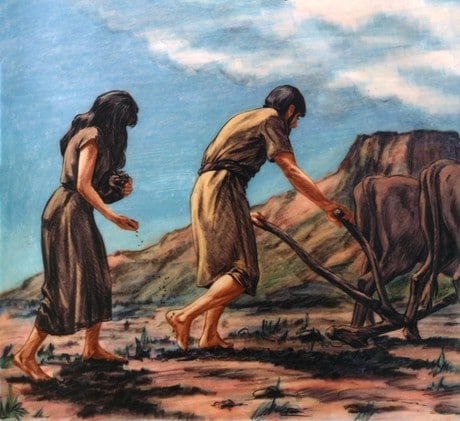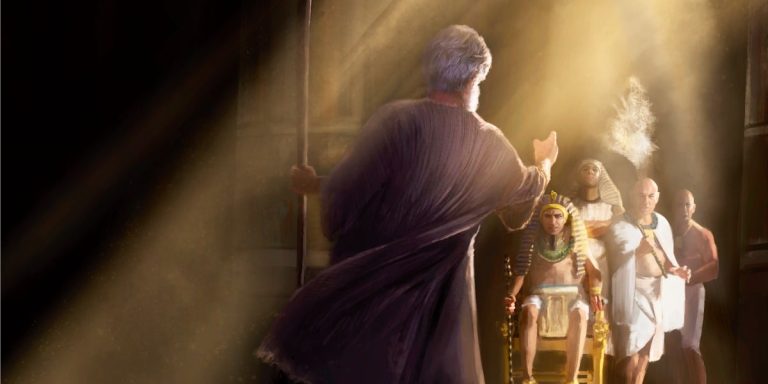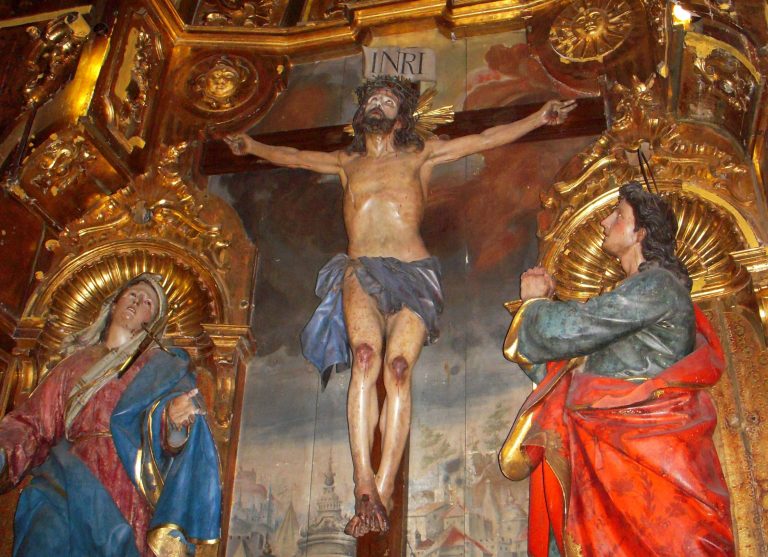Discover a list of the Parables of Jesus
The Parables of Jesus are stories or short stories shared by him. They usually convey a message in a simple way so that they can be easy to remember. The purpose of the parables narrated by Jesus is to teach us how we must act to enter the Kingdom of Heaven. Others also reveal many of his mysteries.
Parables of Jesus
Parables of Jesus are the way that he has so that those who have accepted him in their hearts can understand and remember his word in a simple way and that those who have decided to close their hearts and ears cannot understand him.
Jesus’ parables are his way of conveying his teachings to us using examples from ordinary life, but giving it a new meaning.
The parables of Jesus and their meaning : Not only did they allow him to share his teachings on how to act to enter the kingdom of heaven, love and devotion to God’s call and the importance of this in order to achieve salvation, but also , this was his way of preaching.
After Jesus spent more than a year traveling different roads in Palestine, preaching the gospel and inviting others to follow his path and convert, performing miracles and confirming his doctrine, power and divinity through miracles, some followed him, but others They continued in disbelief.
There are debates about whether the original meaning of the use of parables by Jesus had these intentions, or if in fact, it was added by his disciple Mark when he was persecuted to strengthen the faith of his readers.
This explanation seems to be essential to fully understand the real message that Jesus wanted to convey to us through his parables, since he makes it very clear that it is necessary to have faith, follow him and be open and willing to receive him in our hearts to understand them. otherwise, his teachings and message would go unnoticed.
Both the word and why Jesus taught his teachings through parables have as background the Old Testament, which was originally written in Hebrew. The Greek version (LXX or Septuagint) became predominant when Hebrew became a dead language for the Jews.
The word “mashal” is translated in the Septuagint as “parabolé” or “parable”, although in reality, the term “mashal” can have different meanings in the Old Testament. Interestingly, it very rarely means what we know as parabolic history.
Mashal, then, can also mean: proverb, enigma, ethical maxim, short phrases of popular Hebrew wisdom. Sometimes these “mashal” are given in a poetic way, other times, they invite us to a kind of comparison.
Most of the mashal in the Old Testament does not mean “parable” in the literal sense, that is, it is not understood as an illustrative story or narration.
Yet there are short expressions (not stories) in the Gospels that correspond exactly to what is found in the Old Testament, and are expressly called parables (see Luke 4:23, eg).
This leads us to the conclusion that in both the Old and New Testaments, the term “parable” can have different meanings and a variety of sayings.
Purpose of the Parables of Jesus
Certainly, there is doubt about the purpose of Jesus in communicating through the use of parables, however, we can find said purpose in the passage of Mark 4:10-12
When he was alone, those who were around him, together with his twelve disciples, and asked him about the parables, he told them:
“To you has been given the mystery of the Kingdom of God: but for those who are outside, all things are in parables, so that seeing they may see and not perceive, and hearing they may hear and not understand; so that they do not convert and it is forgiven them”.
If we interpret this literally we can understand that Jesus used the parables as a way to communicate the message of the Kingdom of God to those “outside”, that is, addressed mainly to those who were not yet his disciples.
But isn’t this somewhat contradictory? Didn’t we say at the beginning that he addressed himself rather to his disciples and believers? This perhaps, is one of the tests that make us understand the reason why his true intention is unknown.
Opinions differ as to why Jesus used parables. Some lean towards the idea that it was the way Jesus had to hide from his enemies and non-believers the messages transmitted about the Kingdom of heaven on earth.
Others defend a very different position: that Jesus used the parables with the sole purpose of clarifying concepts that generated confusion regarding the promise of the Kingdom of God on earth. Let’s analyze a little then, some authors and scholars who try to give us a perspective on the “real” purpose that Jesus tried to reflect through the use of the Parables.
CH Dodd (pp. 23,24) a Protestant theologian, known for promoting “accomplished eschatology”: The belief that Christ’s references to the Kingdom of God refer to a more present reality rather than an apocalyptic future.
He alleges that such words were not actually spoken by Jesus, but rather reflect more of a vocabulary of the “Early Church,” specifically, the one that was under the influence of Paul. This explanation then would suppose an attempt of this Primitive Church in trying to explain the incredulous position of the Jews before the preaching of the word of God (Gospel).
Following this guideline, then, God himself would “blind” the eyes of the Jews so that they could not understand, much less accept, the word of God about the Kingdom. Accepting this position then we would be thinking (or imagining) a bitter and vengeful Primitive Church, in the face of constant opposition from the Jews.
The acceptance of this idea would imply not being able to know, without any basis, the purpose that Jesus had in transmitting his teachings through the use of parables.
Joachim Jeremias (the parables, pp 16-22). A German Lutheran theologian and professor of New Testament studies addresses this apparent rejection by the Jews of the passage in Mark (4:10-12).
Through a really masterful discussion and based on his great skill in biblical languages, he concludes that the words written in the passage of Mark are really from Jesus, more however, as an evangelist he decided to give them a different context from the original.
For Jeremiah, there is no doubt that the parable Mark gives us in 4:1-9 is of Jesus and that the words in vv. 10-12 are also from him, but they were placed in a very different context by Mark. According to Jeremiah, the interpretation of the parable vv. 13-20 is definitely a parable thought up and included by the Early Church and not actually said by Jesus.
Jeremiah then concludes that when Jesus referred to the parable in the original context (not the one stated by Mark), he was making no more than a reference to the preaching by his Master Jesus.
It is no secret to anyone that the mysteries of the present Kingdom were revealed to the disciples of Jesus, but for those who are “outside”, they do not see or hear (nor do they want to) these words remain ununderstood.
Nor are they able to recognize their mission, much less do penance. That is why the terrible prophecy of Isaiah 6:9 ss is fulfilled in them “Hearing, you will hear and not understand, and seeing, you will see and not perceive” (the parables, pp. 21,22).
Jeremiah agrees with Dodd on one thing: the text used by Mark and the Early Church was an attempt to show that Jesus egregiously excluded unbelieving Jews from the Kingdom of Heaven.
Let us continue then, with Günther Bornkamm, another Protestant theologian, who taught at Konigsberg, but was subsequently expelled by the Nazis because of his membership in the Confessing Church. He opened new perspectives, offering endless criticism regarding the writing of the Gospels, especially those written by Matthew.
Günter assures that the parables cannot have been said or created with the purpose of generating confusion in God’s messages, since it is unthinkable and illogical that God would hide his teachings about his Kingdom from the Jews for the mere fact that they resisted. to follow him or believe his word.
Rather, he believed that these parables were used by the Master Jesus as a conclusion to the teachings he imparted to everyone (believers or not). He says, “In many similar parables he will speak the word to them, according to what they could hear” (Mark 4:33). This position seems to make a little more sense.
Of course, Jesus, as the Master that he was, imparted his teachings to everyone without exclusion, hoping that everyone would understand, however, it was to be expected that each person would interpret his parables according to their level of knowledge, faith and belief (and reading) of his word (gospel).
In his parables, Jesus used a somewhat mysterious tone, inviting those who listened to him to reflect on their experiences and beliefs, as we mentioned earlier.
Bornkamm clearly expresses that these texts offer a mystery: the apparently hidden advent of the Kingdom of God, since despite not being able to “visualize” said kingdom literally, its believers know that it exists, and even claim to “be able to see” thousands of signs offered by God that it is so and if they follow his path.
It is important to listen, believe and understand all this not from a theory or following a tradition, but rather refers to the personal interpretation that each person may have of each of its teachings.
It is important to recognize that the words of Jesus and their “original” purpose according to Matthew is that they turned out to be incomprehensible to those who lack faith, so the “enemies” of Jesus could not understand him in any way.
From this discussion, Matthew gave it a new context, however, he kept its original order, although he added from the quote taken from the Septuagint (the Greek version of the Old Testament).
Furthermore, Matthew also had the audacity to include an additional verse taken from Isaiah, which implied that a self-hardening of the heart was involved. In other words, those who did not understand Jesus’ parables were not because of their clarity in expressing them, but rather, their misunderstanding was a consequence of their unbelief.
Jones then presents us with the following hypothesis: Could it be that Jesus had Isaiah 6 in mind when making his parable of the sower? It could well be that said parable referred to or is a kind of commentary on the Kingdom of God or a midrash.
If this were true, then we could say that the parable is nothing more than a statement and the interpretation of this will vary depending on the recipient.
On the other hand, TW Manson, who was Professor of Biblical Commentary and Exegesis at the University of Manchester from 1936 until his death in 1958, offers us his perspective on this great confusion in Mark 4.
According to this British writer, the problem is due to an apparent failure in the translation from Aramaic (Jesus’ birthplace language) to Greek (the language used in the Gospels that were written).
Following this new line of thought, Manson believes that Jesus originally would have said that the parables were for those who did not understand, not so that they would not understand (Manson, p. 78).
AM Hunter, an English writer, in his book The Work and Words of Jesus, gives us a summary of the “outs” mentioned about the confusion about the real purpose of the parables used in Mark 4.
The meaning that Mark attributes in 4:11,12 that Jesus “used parables to blind and harden people” is really absurd. So Hunter proposes 4 possible solutions to somehow clarify this “mystery”:
- The words are from the later Theology of the Church which purports to explain why the Jews rejected the gospel as a “whole”.
- They are a kind of Semitic determinism put on the lips of Jesus and expressed in an ironic way in Rom 11:8 “As it is written: God gave them a spirit of stupor, eyes that do not see and ears that do not hear, until the day from today”.
- “Jina” (Greek term translated or employed as “so that”) is the same as “Joti” (Greek term translated or employed as “because”). Matthew 13:13 expresses “Joti” instead of “Jina” which appears in Mark, which, means that “outsiders” or unbelievers lack spiritual maturity, for such a reason, Jesus sees himself in the need to use a parabolic language.
- “Jina” is a mistranslation from the Aramaic, which was rather ambiguous. It could function as “who” (relative pronoun) or as “what” (conjunction). Put another way, “outsiders” are those who possess spiritual immaturity.
Classification of the Parables of Jesus
The classification of the parables of Jesus vary according to who interprets it. According to Thomas Walter Manson, an English biblical scholar can distinguish or identify two (02) classes of parables in the Old Testament.
Like the parables of Jesus that can be divided into two (02) general classes, obeying the same principles of said classification.
A first class refers to a type of human behavior, that is, it appeals to a more ethical-human conscience. On the other hand, the second class refers to the Kingdom of God on earth, this, for its part, appeals to revive or strengthen the listener’s faith.
Regardless of the different groupings of parables, we can notice that the parables of Jesus are broken down in a much more peculiar way. For example, there are parables of Jesus that are nothing more than “sayings”, an example of this could be: “You are salt of the earth” in Mat 5:13 Another example would be, “No one can serve two masters” in Mat 6:24
This class of sayings seems to predominate in the Gospel of Matthew, specifically in the “Sermon on the mount”:
“When Jesus heard this, he said to them: The healthy do not need a doctor, but the sick do. I have not come to call the righteous, but sinners” (Mk 2:17).
“No one puts a patch of new cloth on an old dress; otherwise, the same new patch pulls on the old, and the breakage becomes worse” (Mk 2,21).
Also, we can find an example of this in the Gospel of Luke:
“He said to them: Surely you will tell me this saying: Physician, heal yourself; of so many things that we have heard that have been done in Capernaum, do also here in your land”. (Lk 4. 23)
Obviously, this kind of “parable” is not the one we referred to at the beginning, which is an illustrative story or narrative, but rather, we could consider it a “germ parable”. In these cases, the “seed” is a kind of “comparison”.
Also, there are longer parables, these can be considered more like “similarities”. These types of parables detail a common or typical situation and are accompanied by an appeal, demand or requirement of a common experience that we could live in our daily lives.
In general, these begin with a kind of comparison, examples of this:
“Furthermore, the kingdom of heaven is like treasure hidden in a field, which a man finds, and hides it again; and rejoicing over it he goes and sells all that he has, and buys that field (Matt. 13:44)
“Also the kingdom of heaven is like a merchant seeking fine pearls”… (Matt. 13:45)
Because “which of you, wanting to build a tower, does not first sit down and calculate the expenses, to see if he has what he needs to finish it? Lest after he has laid the foundation, and he cannot finish it, all who see it begin to make fun of him”… (Luke 14:28–32)
Then he told them this parable, saying: “What man of you, having a hundred sheep, if he loses one of them, does not leave the ninety-nine in the wilderness, and go after the one that is lost, until he finds it?
And when he finds it, he puts it on his joyful shoulders; and arriving home, he gathers his friends and neighbors, saying: Rejoice with me, because I have found my sheep that was lost.
I tell you that so there will be more joy in heaven over one sinner who repents than over ninety-nine righteous people who do not need repentance.”… (Luke 15:3–7).
A third class or type of parable used by Jesus could be defined as a narrative parable. In this type of parable there is much more than a simple painted picture, a whole series of events is detailed with the intention of transmitting a teaching, in other words, this type of parable aims to leave us a moral.
Although there may be some exceptions, we can say that this kind of parable can be found mostly in the Gospel of Saint Luke. Without a doubt, narrative parables are the ones that best fit the definition of “parable”, so it is the one with which we are most familiar. Let’s see an example of this:
“Then Jesus began to tell them in parables: A man planted a vineyard, fenced it in, dug a winepress, built a tower, and leased it to some farmers, and went away.” And at his time he sent a servant to the tenants, that he might receive from them of the fruit of the vineyard.
But they seized him, beat him, and sent him away empty-handed. He sent them another servant again; but stoning him, they struck him on the head, and they also sent him away disgraced.” He sent another one again, and this one they killed;
And many others, hitting some and killing others. Finally, having still a son of his, beloved, he also sent him to them, saying: They will have respect for my son. But those farmers said among themselves: This is the heir; come, let us kill him, and the inheritance shall be ours. And taking him, they killed him, and drove him out of the vineyard.
What then will the lord of the vineyard do? He will come, and destroy the husbandmen, and give his vineyard to others” (Mark 12:1–9)
Dodd is one of those who believe that it is not feasible to distinguish radically between the different classes of parables, what if it is necessary to know how to differentiate is the grammatical phenomenon present in each of these. We can summarize and classify them then as follows:
- Parabolic sayings: There is usually only one verb and it is in the present tense.
- Simple parables: There is more than one verb, however, it is also in the present tense.
- Narrative Parables: There is a plurality of verbs and these are found in a historical past tense.
There is another scholar (Hunter) who, through his work Interpreting the Paraboles, supports and shares this classification.
Ray Summer also classifies the parables of Jesus into three (03) large groups, according to the parables found in the Gospels, however, this differs from the classifications that we have highlighted so far, since for Summer most of the parables categorizes or includes them as “Parabolic Stories.” An example of this:
Parable The Two Foundations: “Whoever hears these words of mine and does them, I will compare him to a wise man, who built his house on the rock. The rain came down, and the rivers came, and the winds blew, and beat against that house; and it did not fall, because it was founded on the rock.
But whoever hears these words of mine and does not do them, I will compare him to a foolish man, who built his house on sand; and the rain descended, and the rivers came, and the winds blew, and beat against that house; and he fell, and his ruin was great.
And when Jesus finished these words, the people were amazed at his doctrine; for he taught them as one in authority, and not as the scribes” (Matt. 7:24–29); We can find more examples of this type of parables in Matt. 7:24–29, Mat 12:43–45 or Luk. 7:41–44.
Then, within the classification according to Summer were the “seed parables or sayings”, some examples of it Mar 2:19-22 and Luc 6:39, let’s see one of them:
“Jesus said to them, Can those who are at the wedding fast while the bridegroom is with them? As long as they have the husband with them, they cannot fast. But days will come when the bridegroom will be taken from them, and then in those days they will fast.
No one puts a patch of new cloth on an old dress; otherwise, the same new patch pulls on the old, and the breakage is made worse. And no one pours new wine into old wineskins; otherwise, the new wine breaks the skins, and the wine spills, and the skins are lost; but new wine must be poured into new skins” (Mark 2:19-22).
The third classification according to Summer are “Parabolic Acts”. Although we can note that up to this point there was no great difference (in terms of classification) with respect to Jones and Dodd, this third classification does differ. We can find examples of these in: Matt. 21:18–22; Mark 11:12–14, 19–25; Jn. 2:1–11; 5:1–18; 6:1–71; 9:1–41).
This last classification according to Summers included more actions than words. Mainly, the parabolic acts referred specifically to an act of Jesus or another that illustrated a true comparison.
Hunter, in his work, finds around 60 parables contained in the synoptics, of which four of these teach by example and not by means of an analogy. Among these some of the most prominent are: the Pharisee and the publican, the rich fool and the good Samaritan, the rich man and Lazarus.
Let’s see an example then to better understand what he meant by it.
“At this point an expert in the law appeared and, to put Jesus to the test, he asked him this question:
“Teacher, what do I have to do to inherit eternal life?”
Jesus replied:
“What is written in the law?” How do you interpret it?
In response the man quoted:
—“Love the Lord your God with all your heart, with all your being, with all your strength and with all your mind”, and: “Love your neighbor as yourself”.
“Well answered,” Jesus told him. Do that and you will live” (Luke 10:25-28)
Will Marxsen seems to share this same classification, with the difference that in one of his classifications he refers to the “Exemplary Stories”.
One of the most accurate ways to highlight a parable and differentiate it from other comparative stories is to note that the parable is not essentially literal fact. Adolfo Jülicher shows us that the nature of the parables of Jesus are not literal, in addition, he makes the point that we must radically distinguish them and not confuse them with a simile or a metaphor.
Although in the New Testament we can note the existence of allegorical interpretation of parables, we consider it important to highlight the fact that the parable is based mostly on similes and not on metaphors.
Some of the big differences between allegory or literal facts and a parable is that the parable has only one message or teaching to convey. The allego has several points of comparison while the parable has only one.
The biggest difference between these is the fact that the parable shows a fact of everyday life and also a very realistic fact, so that whoever listens to it generates great identification and can understand it immediately.
The parables of Jesus, although they may have had their bases in real life chapters, their purpose in telling them was not limited to giving historical or biographical data, but they went further. The parables of Jesus stand out for their realistic atmosphere, while the allegory is more fanciful and incredible facts.
Hunter highlights three aspects of the parabolic teachings of Jesus that help to better understand this type of story, let’s see what they are:
The first feature: The parables are examples taken from daily experience or common practices, so they were not only stories that were told with an end, but also, they included repetition to bring the reader to a kind of “climax” in the lesson you wanted to highlight.
They emphasize the distinction of what was considered “right” or “wrong”, between “good” and “evil”; It was common to use a combination of the number three in stories to highlight the main characters. We can see this in the parable of the Samaritan, for example.
The second feature of the parabolic teachings of Jesus that Hunter highlights is that the parables used by him were based on facts of everyday life; The third feature Hunter highlights is that Jesus used parables to elicit a response, reflection, or analysis from his listeners.
Jones points out the existence of “clusters” of parabolas, that is, those that are grouped in a natural way. A “cluster”, for example, can be grouped based on the promise made by the father of the earthly paradise.
Conceptual Map of the parables of Jesus
The conceptual map of the parables of Jesus could be summarized and better understood with an image.
List of Parables of Jesus
Below we share with you an extensive list of parables of Jesus , with their respective interpretation and the message that he wants to convey to us:
The parable of the sower
This parable gives us a beautiful message. The “sower” is represented by the one or those who share the word of God through the Gospel with others, and the “seed” is the message that God has for us.
The parable of the tares
First, let’s understand what is tares? Tares is to generate or promote a conflictive environment. Now, as for the parable, it refers to several elements.
If we had said that the “sower” was the one who shared the word of God and the “seed” the message of God for us, then the one who sows the good seed is the Sons of the sowers, that is, the sons of the mens. The field represents the world; the “good seed” are the children of the kingdom of God, that is, those who believe, have faith and follow God’s path, and the tares are the demons, who always invite us to give in to temptation and commit sin.
The parable of the mustard seed
The Kingdom of God is similar to a mustard seed. Let us remember the teaching of Jesus when he invites us to “be like children” since the Kingdom of Heaven belongs to these. The mustard seed then in this case is like planting a tree, watering it, taking care of it and watching it grow. Obviously, here it refers to our spiritual side, to our conversion of heart, to renewing our faith and making it grow.
parable of the yeast
Put simply, it refers to internal growth, and then to be able to externalize and manifest that internal growth.
The parables of the hidden treasure and the pearl
With this parable, Jesus tries to show us how lucky we are to believe in the father’s promise and to one day be able to share the Kingdom of heaven on earth with him.
parable of the dragnet
Let’s look at the parable this way: the Kingdom of Heaven represents a great net, which can catch many things, but in reality, it seeks to “catch” men of faith. Does this sound similar to Luke 5 and the miraculous catch of fish?
Parable of the lost sheep
One way to interpret the message that Jesus wants to give us through this parable would be: God always takes care of us and guides us. If at any time we lose the north, it offers us his mercy, allowing us to get back on track again.
Parable of the lost dragon
This parable shows us that the “currency” is us. Like the parable of the lost sheep, we are for God like that coin, super valuable! He will do everything possible to find us and for us to follow his path, but it is also up to us to respond to his call.
parable of the prodigal son
One of the most recognized parables of Jesus. God shows us the relationship of a father with two sons. One, who is obedient and does not question his father, the other, is so rebellious that he leaves home. This is our relationship with God. Some follow him, others do not, however, God is always willing to welcome us again with open arms, just as a father would with his son.
Parable of the workers at the eleventh hour
In this parable we can appreciate several things. First, the father of the family is indisputably God. He calls us all, but as it is said “many are called but few are chosen”. Second, God wants us to be with him, to enjoy his grace, his love and his kingdom, but if we don’t decide freely and give ourselves to him willingly, he won’t force us.
Parable of the wedding guests
When we accept God as our king, we are not only accepting him, his love and his grace, but we are also accepting his banquet (his body and blood), and this is what he wants for us. May we enjoy all the blessings and grace that he offers us.
The question of inheritance
This is what God refers to with the parable The question of inheritance: There is no greater blessing and wealth than having God in our hearts and in our lives and joyfully receiving everything he gives us daily.
God shows us that although many follow him, not all practice what they preach. Some allow themselves to be dazzled by material goods and earthly pleasures, even greedily, desiring the goods of others and even another’s wife. Others, on the contrary, decide to serve the Lord and lead a humble and simple life just as his son did.
The manager’s parable
It is the way that God communicates to us that cunning is always related to the evil one, on the contrary, our duty as Christians is to be fair, to be rather sagacious and not to act with bad intentions taking advantage of the needs of others.
The barren fig tree
The barren fig tree refers to a people far from the way of the Father. Through his mercy he gives us the opportunity to repent with heartfelt repentance and not have to wait to be judged and condemned as sinners. Let us avoid misfortune by following the path that God proposes to us.
The parable of the rich man and poor Lazarus
The main message that God wants to give us through this parable is simple: the rewards that we will enjoy eternally will depend mainly on the decisions we make now (present tense) and on our actions throughout our lives.
parable of the good samaritan
One of the most beautiful parables: It represents the life that every good Christian should lead. Being a “good Samaritan” is not simply going to mass, congregating, knowing the prayers by heart and preaching the gospel, but rather, practicing what is preached and being willing to support others without judging them.
The Parable of the Pharisee and the Publican
This parable shows how acknowledging ourselves humble before God and accepting our sins allows us to draw closer to God. The Pharisee, although he did not offend anyone, sinned with arrogance, believing that his life was perfect and that by his actions he had assured the kingdom of heaven. On the other hand, the publican recognizes himself as humble and “sinful”, that is why he is finally forgiven and receives God as his savior; It is not doing, but being and recognizing.
parable of the two sons
This parable teaches us to say “yes” to God without thinking and invites us to commit ourselves in actions and not with words and promises. Let’s avoid being like the son who says “no” or lives postponing his commitments.
Parable of the foolish and wise virgins
God represents the “groom” and the “ten virgins” symbolize the different Churches as a single body: World Church; Knowing that God is coming and waiting for him is not enough, we must be spiritually prepared and not “fall asleep” because God has not yet come again: let us pray more, let us love more, let us evangelize wherever we go.
parable of the talents
It does not speak of material wealth, but of those who have approached God but do not really believe in him.
parable of the final judgment
God reminds us that life is fleeting and that he will come a second time as King and will judge our actions, will we be prepared?
parable of the unjust judge
God emphasizes that we pray without fainting, invites us to be like the widow, praying and keeping the faith of his return. God, unlike the judge, is just.
Parable of the homicidal vinedressers
Some believe that they will be heirs to the Kingdom of God simply by belonging to a religious circle and calling themselves “believers”, however, God tells us that they will be totally disinherited by acting in an unfair, abusive, immoral or criminal manner.
Parables of Jesus for children
The parables of Jesus for children do not have any difference, simply, they must be adapted in the way they are shared, that is, adapt them to a more childish, simpler language, so that children can understand it much better. Of course, it is possible to emphasize parables that refer to children, for example, the parables of the wheat, the prodigal son, the daughter of Jairus, the multiplication of loaves, the Pharisee and the publican.

Hello! Let me enthusiastically introduce myself as a dedicated blogger fueled by an intense passion for meticulously crafting insightful and well-researched blogs. My mission revolves around providing you, dear readers, with a veritable treasure trove of invaluable information.







